The Best Pouring Mediums For Acrylic Pouring: Naming the Cheapest and Best!
It doesn’t have to be hard to get started acrylic pouring, but you may be getting confused when you see there are many different pouring medium brands.
They vary in cost and effects but overall – they are all pretty similar!
The most important thing is that you aren’t ripped-off especially considering that fluid artists need quite a lot of pouring medium in this style of art.
That’s why we made this guide, to help you make the decision on what pouring medium to go with.
[TS_Poll id=”1″]

Different brands and types of pouring mediums have different effects in acrylic pouring. Some pouring mediums are better for lots of cells, whereas some are better for less.
Some pouring mediums provide longevity to your artworks, whereas others reduce the lifespan of your artwork!
In this article we are going to go over which pouring mediums are the best quality and the most economic for price.
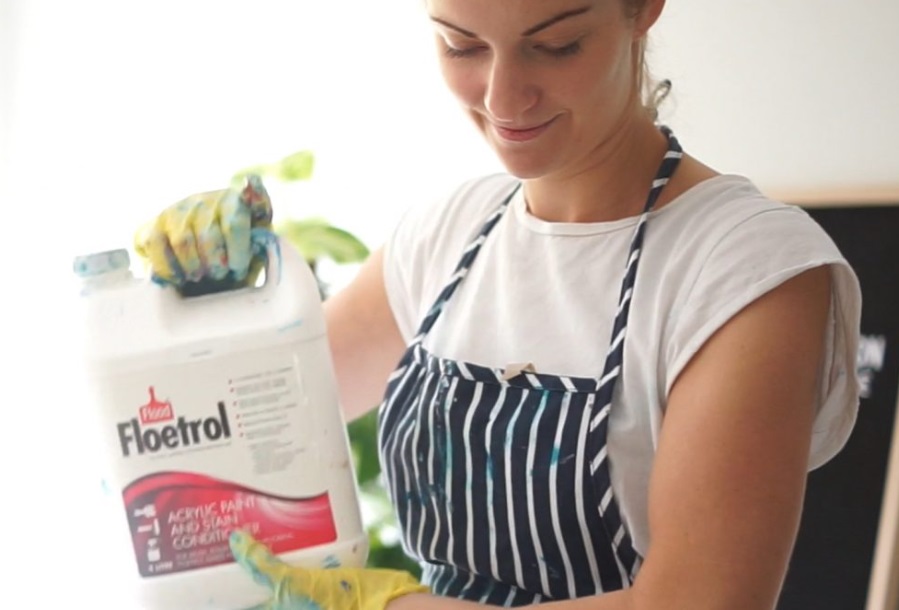
Some people want to create acrylic cells, others just want the best professional quality on the market and some want the best option for bulk creating artworks. No matter what you’re looking for, we have listed it below.
Plus we will help you with: how to deal with the lumps you often get in pouring mediums?
It took me a little while to find the best pouring medium for what I wanted to achieve in my works, so I have compiled a list below to help you find the perfect medium for you!
I also share my personal all-time favourite pouring medium…
Today you will learn:
- What is a pouring medium?
- Types of pouring mediums
- 1) Art Store Pouring Medium – Recommended
- 2) Hardware Store Pouring Medium – Recommended
- Silicone for more cells
- 3) PVA Glue – Not Recommended
- 4) Just Water – Not Recommended
- How to deal with lumps
- Paint pouring mix recipes/amounts
- The difference between pouring mediums
- How acrylic paint thickness affects how much pouring medium you use
- How much pouring additive to add
- The art of experimenting with paint pouring
- Why does it take so long for my acrylic pour painting to dry?
- What can be used as a pouring medium
- FAQ
What is a pouring medium?
A pouring medium is simply a liquid which is added to your acrylic paints to thin out their consistency. Why? To help paint pour onto a canvas and flow smoothly.
Pouring medium is like glue, it acts as a diluting agent and a binder (keeping the pigment together) for your paint. The best pouring mediums help retain vibrant colour and gloss of your paint too.

Apart from helping to loosen up paint so you can pour, pouring medium can also help to create what is known as acrylic cells and other beautiful patterns in fluid art. Some pouring mediums do this better than others! (See below for answers)
Pouring medium is the secret ingredient behind achieving beautiful fluid artworks! It can also improve the integrity and qualities of your acrylic paint – meaning that your paintings dry level, without cracking, separating, or fading.
It makes acrylic paint easier to work with and suitable for pouring!

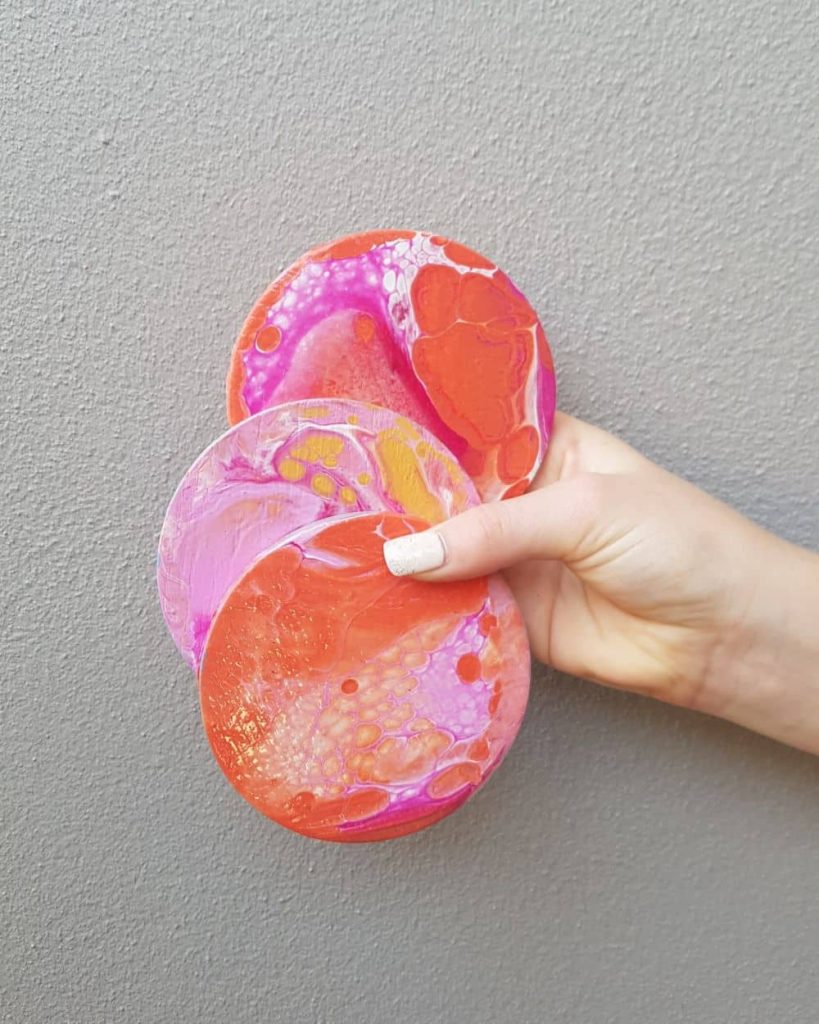
The four main types of pouring mediums
1) Art Store Pouring Medium – Recommended
Art store pouring medium is popular for artists because it is purpose created for acrylic pouring. Meaning the quality, consistency and finish will be the most professional out of all options.
The most popular artist pouring medium brands with the best reputations are as follows:
Professional Quality: Liquitex Pouring Medium
$1.09 per oz: Popular because it has been designed for acrylic pouring artists
| Pros | Cons |
| Professional choice | Reasonably expensive |
| Marbling effects with some cells | Floetrol may make better cells |
| No lumps or cracking | Must buy at speciality shops |
| Self levelling, great flow | Some prefer matte finish |
| Glossy finish | |
| Non-Yellowing (UV Stable) |
Value for money: Pouring Masters Gloss Pouring Medium
$0.72 per oz: Best value for money on the market.
| Pros | Cons |
| Value for money | Not as professional |
| Good cell generation | Mixed reviews on finishing quality |
| Good for beginners on a budget | Must buy at speciality shops |
| Some cells but mainly marbling | Some prefer matte finish |
| Glossy finish | Too runny! |
| No lumps | Too watered down. |
Art Store Pouring Mediums Pros:
- Should not crack when dry (However outside environmental influences and cheap watered down acrylic paint can result in cracks)
- Dries without bubbles
- Easy to use
- No lumps!
- Purpose made for artists
- Keeps your paint colors vibrant
- Creates some acrylic cells
- Glossiest finish
- Good “flow” and coverage
- Self-levelling
- Leaves paint opaque (Doesn’t go see-through)

Cons:
- Harder to find/buy than other options
- Less cells than other choices
- The most expensive option
This type of pouring medium is purpose created for art use. It is one of the best choices for this reason.
Craft Store Pouring Mediums can create great fluid effects and achieve pouring techniques and acrylic cells especially when mixed with a couple of drops of silicone.
Pouring Medium from the craft shops helps to thin the paint but they don’t compromise the paints strength, vibrancy and transparency.

Many craft store pouring mediums are self-levelling and have a gloss finish when they dry.
The main problem is that it is more expensive than other options. Our favourite option is listed next!
Also, sometimes it’s harder to purchase in a hurry. For example, on a Sunday afternoon if you want to get creative, you can’t just quickly go and pick it up from the shops because it will likely be closed.


2) Hardware Store Floetrol – Our personal favourite
This is the best choice for people who want to create a lot of artworks. It is economical, easily available and you can buy it in bulk from the local hardware store!
Our pick: Bulk Buy Flood Floetrol
$0.17 per oz!: The most economical choice among pouring artists
| Pros | Cons |
| Cheapest option | There are lumps in it |
| Shouldn’t crack | Can make work transparent if not enough acrylic paint added |
| Easy to use and buy from hardware stores | Not created for artists but we use it anyway |
| Many cells | Some prefer glossy finish |
| Matte finish | |
| Good quality |
Value pack: Flood Floetrol
$0.46 per oz: Often the bulk buy goes out of stock. This is the next best option.
| Pros | Cons |
| Cheap option | There are lumps in it |
| Shouldn’t crack | Can make work transparent, the finishing quality can vary for beginners |
| Easy to use and buy from hardware stores | Not created for artists but we use it anyway |
| Many cells | Some prefer glossy finish |
| Matte finish | |
| Good quality |
Flood Floetrol Pros
- Cheapest option
- Creates lots of acrylic cells
- Easy to buy in bulk
- Dries with a slight glossy finish
- Leaves paint opaque (if you dont add too much floetrol if you add too much it can dry clearer)
- Dries without bubbles
- Easy to use
- Self-levelling
- Good pouring consistency and flow

Flood Floetrol Cons
- It has lumps! (Which you can use a sieve to filter out)
- Still can be costly!
- Still need to add water to make it pour correctly
- May cause yellowing overtime or reduce the longevity. However this is argued, because it is used by house painters so it has to be good quality for professional painters too.
Flood floetrol (Paint conditioner) is commonly used and surprisingly effective in pour painting across the world.
The best way to get more cells is using silicone oil.

For the most cells: Cell Activator Silicone Oil
Many acrylic pouring artists want big, beautiful cells. The best “Cell activator” for pour painting is 100% silicone oil.
| Pros | Cons |
| Cheap and effective | Reduces longevity of work |
| Creates many big cells in artwork | Can leave a film on artwork (which you can wipe off carefully) |
| Easy to use | Can have a yellowing effect on art but this is disputed |
| Only need a few drops | |
| 100% silicone | |
| Created for artists |
Here’s why Flood Floetrol is our number #1 choice as a pouring medium for beginners and experienced artists alike:
There is no barrier of entry to beginners
It can be found at hardware stores for a fair price look in the paint section for “flood floetrol” or “paint conditioner”.
The good thing about this choice is that you can easily get your hands on it. Hardware stores are found in most suburbs and open seven days a week. Even open late! You can also purchase it on Amazon. It usually comes in one quart or one gallon (one litre or four-litre) sizes.
I regularly use floetrol for my artworks and I am so happy with the results.

I often get acrylic cells, and if I am not getting enough I just add a couple of drops of silicone oil and lightly torch the artwork with a heat gun (I buy silicone oil from the craft store and lasts ages).
The only problem is that sometimes I get little lumps in the floetrol.
However, you can get around these by filtering your floetrol when mixing it with your acrylic paint. Simply use a metal strainer with small holes in it. Run the floetrol through the strainer and then add it to your paint.

Make sure you immediately wash your strainer and make sure you never use that strainer in the kitchen again. So it doesn’t dry on it, ruin your strainer or harm your health!
3) PVA Glue – Works for some people
Pros
- Affordable
- Easy to find/buy
- Pours well if you achieve the right consistency
- Self-levelling
- Not “archival quality” can break down overtime due to acid in this product
Cons
- Very difficult to get the right ratio to mix
- Little or no acrylic cells
- Doesn’t flow as well in general

PVA glue is a controversial option in paint pouring. PVA Glue is inexpensive and easy to find. You can buy it in bulk for about half the cost of other pouring mediums.
But PVA glue is much thicker than other pouring mediums, making it difficult to get the right pouring consistency.
PVA Glue does not create many acrylic cells, which are popular in this form of painting.
At the end of the day it all depends on what you want to achieve.
4) Just Water – Not Recommended
Water is often used by beginners to thin out the paint and in most cases, it works to simply thin the paint. It is obviously the cheapest liquid!

I have tried it myself, however, for me it doesn’t work.
However water is a great additive to other pouring mediums to loosen them up even more….
The problems with just water
If you only add water or add too much, it will end up diluting your colors which means that the vibrancy of your paints is affected. Not only this, but it will also dilute the binding agent. In this case the painting will not stick as well to the surface and may even just run off the surface completely.
Sometimes too much water in a mix will soak the surface so much that it bends out of shape. You will find that problem especially when pouring onto canvas, canvas board, paper or card.


Water in high amounts, does not bind correctly with acrylic paint. The results can end up with an uneven consistency on your canvas and the paint pigment will separate. When it dries your paints can flake and lift off the canvas and layers won’t stick to each other either.
It will definitely affect the quality and vibrancy of your painting, which is why it is a much safer option to go with a well-known or store-bought brand of pouring medium.
A good pouring medium is imperative to a good result when starting out with acrylic paint pouring.
It will retain the integrity of your paint and you will be much happier with the end result, trust me!


Paint pouring ratio/recipe amounts
A basic recipe for paint mixing using pouring medium and acrylic paint is as follows:
- Half a cup of paint
- Half a cup of pouring medium (Sometimes a full cup of pouring medium depending on the thickness of the paint)
- One tablespoon of water
Mix thoroughly.
Adjust accordingly, if the paint mix is very thin, simply add a little more acrylic paint. If it is too thick to pour evenly, add more water and pouring medium.

This will create a nice pouring consistency so you can begin acrylic pouring.
The recipe however can be affected by the technique you are doing. For ring pour and flip cup you want the paint to be thinner than other techniques. This is so that the paint pours and creates a big ripple on the canvas, spreading well.
For blowing waves or using a hair dryer you want your mix to be slightly thicker, otherwise it will run too fast and lose some of its shape and acrylic cells straight off the canvas.
The difference between pouring mediums
There is a huge range of pouring mediums out there to try, but what makes a good pouring medium?
They can vary in their purpose to improve the fluid dynamic of the paints, making them flow easier over the canvas.
Make sure you read the packet carefully to know what attributes different brands have at the craft store.
They will say if they have a glossy finish, you want a brand which is UV stable because this will help stop the paint from yellowing in the sun.
If the medium is advertised as having a gloss finish, this will change the look of your painting when it dries, giving it a nice sheen to the finish.
However, you can get the same effect by using a regular medium and adding a gloss coat (varnish or spray gloss) afterward.

Most acrylic paint pouring mediums are all-purpose, which means that they are the optimized consistency, flow, and binding for your acrylic paint.
Floetrol and Liquitex are two popular examples of these all-purpose acrylic pour medium. There are also many more specific products on the market which are intended for pouring paint.
Pouring Mediums have added preservatives to make your art last longer.
The best medium depends on several factors, it differs on a personal level but also your technique and acrylic paint brand.
How acrylic paint thickness affects how much pouring medium you use
Different acrylic paints will affect the amount of pouring medium you will use in your pour painting.
A thicker paint like Liquitex Basics, or some of the artist quality paints can be really thick due to having concentrated pigment to make it more vibrant.
With a thicker paint you will need to add more pouring medium to get a good flow consistency.
An example recipe for thicker acrylic paint is 1 part acrylic paint to 1.5 part acrylic paint pouring medium plus a tablespoon of water to get a good consistency for a pour painting.
Thinner paint with more water in it, will obviously need much less medium, more of a 2:1 ratio.

How much pouring additive to add?
Do I have a thin or thick acrylic paint?
If your paint pours out of the container on its own, then it has more of a water base and is a thinner paint.
If you have to scoop it out or squeeze it hard, then it is likely a thicker paint.
Thinner paints are often student quality, poster paint or house paint.
Thicker paints are usually artist quality.
Both thin and thick paints a great for paint pouring, the only difference is in your paint pouring mix!
The art of experimenting with paint pouring
Experimenting with many different mediums is a great way to find what works best for you.
Try different brands, different ratios, different consistencies.

Eventually, you will find what works best and you will never look back!
Most experienced painters have their favorite product and do not stray far from it. They have their personal recipe for the best consistency for them and rarely deviate from it.
Start with whatever medium is available to you and what suits your budget.
Test it with your favorite paints and see the results.
Try different ratios if you are not happy with it at first and see how it compares. You may find that PVA glue/floetrol gives a better result for you than some of the premium products out there!
A word of warning
Make sure you just use one or two pouring additives at a maximum at a time plus water.
If you divert and mix lots of different things, your paint mix might separate or not give you your desired results!
Some beginners accidentally mix an oil based paint with a water based pouring medium, this will separate in a bad way!
Why does it take so long for my acrylic pour painting to dry?
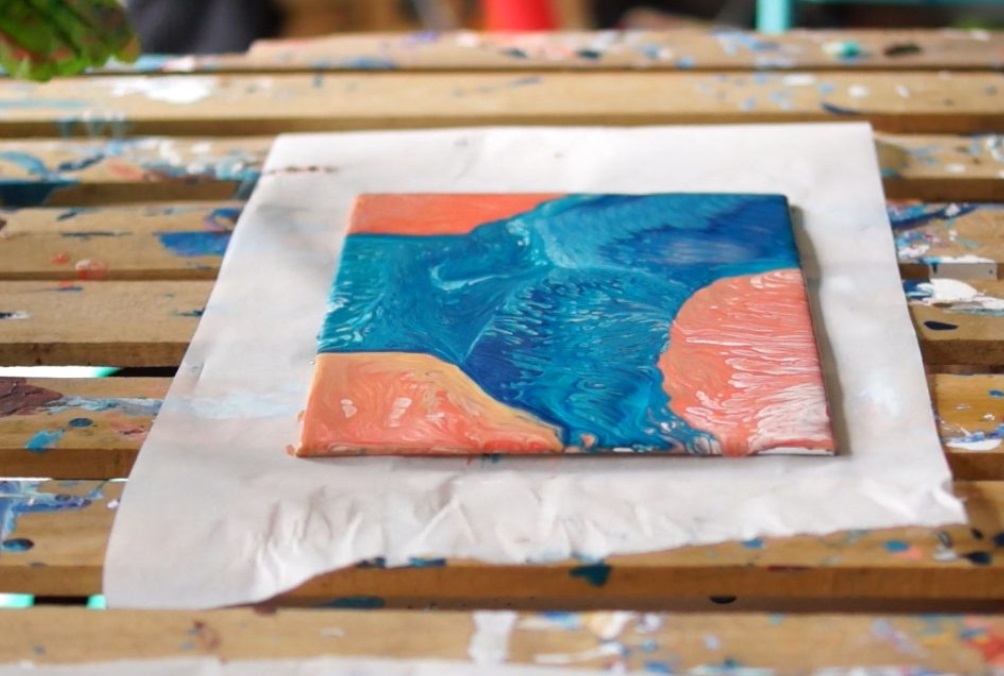
There are many advantages to working with pouring mediums. They bind to the paints, as opposed to water which naturally separates if you add too much!
They do not result in separation or weakening of the paints.
Most even strengthen the paint and prevent cracking when dry.
Good pouring mediums like Liquitex and Floetrol do not sacrifice color, maintaining the vibrancy.
Sticking to reasonable ratios will ensure this.
Pouring mediums do extend the drying time of the paint, so don’t be surprised if it take several days to dry.
This also makes your paint easier to work for a longer time.
You have more time to ensure that the finished product is exactly how you imagined it, if not better when the drying time is longer. You can get the perfect finish to the cells, clean up the edges of the canvas, and do your last-minute tweaks!





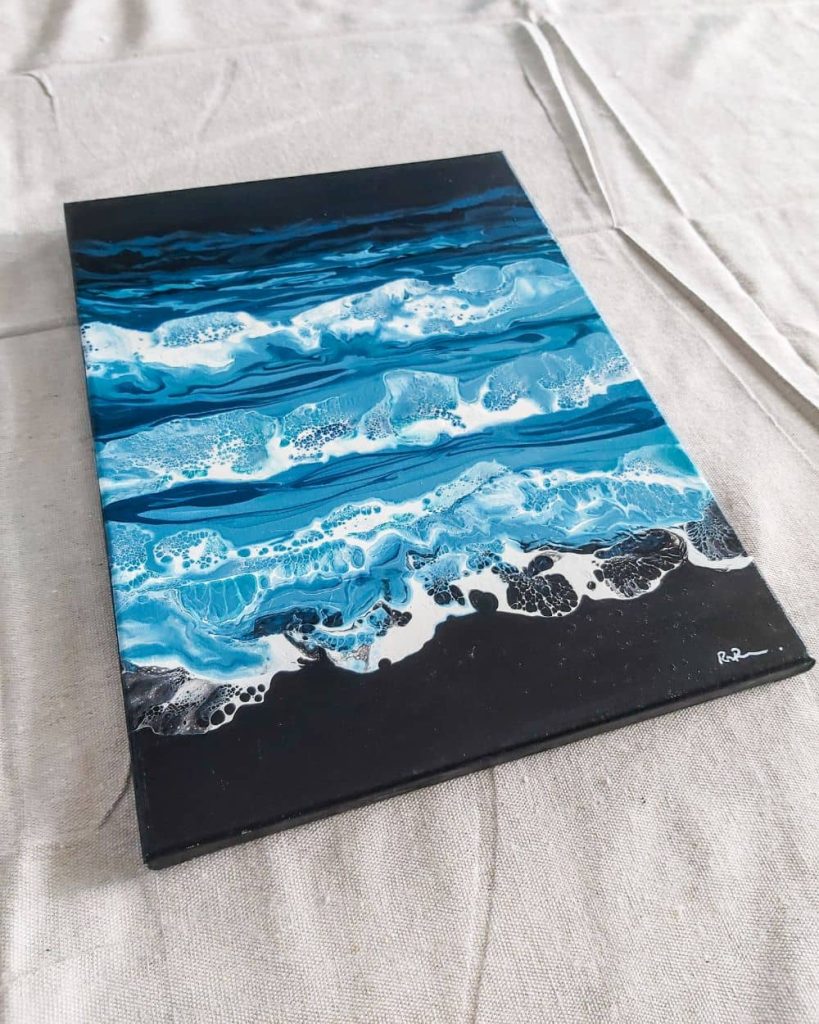
Frequently asked questions
What can I use for acrylic pouring medium?
If you are just starting out, and don’t want to break the bank by buying many expensive products, then there are alternatives to professional pouring mediums.
Flood floetrol, is a great beginner – intermediate option for a cheaper pouring medium.
Or dare to try PVA Glue!
All-purpose mediums would also be perfect, such as GAC800 or Liquitex Pouring Medium.
All of these can be purchased on Amazon, but they are widely available in local craft stores or hardware stores too!
Can I make my own acrylic pouring medium?
In short, yes! You can definitely try your hand at making your own pouring medium and it is fairly easy to do but not without its learning curves through mistakes and messed up batches.
You can mix two different mediums, like Floetrol and PVA glue to make a medium that suits your needs better if they don’t work in the way that you want them to. Plus a touch of water if it is too thick.
Make sure you strain the pouring medium through a mesh paint strainer to avoid any lumps before use. Lumps form as these products settle, but there is no need to throw them away!
You can start by mixing Floetrol and PVA glue in a ratio of 3:1. Combine and stir thoroughly and make sure they are well combined to avoid unwanted separation during use.
You can add a little more of one or the other to get the desired consistency. You can store this for up to a week before you will have to mix more.
What can be used as a pouring medium?

One of the most popular professional pouring mediums is Liquitex Pouring Medium. It is aimed at artists and has a great consistency for acrylic pouring.
Due to a sharp increase in the popularity of acrylic pouring the company has found it hard to keep up with the demand. This resulted in a large increase in the cost, so this brand can be quite pricey. But if this is out of your price range, especially when you are just starting the hobby, there are alternatives!
Floetrol is sold in hardware stores around the country and is cheaper and can be found in larger quantities too. It is a great option in comparison to the ‘art’ brands.
It is sold as a paint extender and thins paint for spraying, which makes it perfect as a pouring medium as well.

The preference is really a personal choice. When it comes to Liquitex vs Floetrol it comes down to what you are looking for in a pouring medium.
Floetrol is great for beginners to intermediate artists and advanced artists even use it as it promotes the formations of cells. It is a great standalone pouring medium.
GAC800 is the equivalent to Liquitex Pouring Medium. It is designed specifically for this purpose. However, the main difference between the two is that GAC800 is designed to be used in a very high ratio compared to paint. This can be up to 10 part GAC800 to one part acrylic paint.
It does prevent cracking in your finished piece and results in very thick layers of paint on the canvas.
PVA glue is one of the cheaper alternatives that most beginners used as I have mentioned above. It is easy to source and is even popular with more advanced artists, being seen extensively on YouTube tutorials. However it is harder to get the mix right, because it is so thick. It doesn’t produce as many acrylic cells. It is not the best quality and the art may not last as many years as other options.
Lineco 901 helps to preserve the acrylics if you plan on storing then for a long period. If eventually, you think that this will be more than just a hobby, or you want to make a painting for a family member or friends, then this will help to preserve the piece for years to come.
In saying this, Liquitex and Floetrol do pretty much the same thing.
Finally, we have Novaplex 233 which is made by a small company in California. Its a popular and commercial alternative to Liquitex. But you may pay a pretty penny when shipping costs are added as they can be quite expensive.
Is high flow acrylic a pouring medium?
Flow or fluid acrylics are paints that are designed to be used instantly without needing to mix your own, for pouring. They are not specifically a pouring medium, they do not need the added medium, water, or silicone to start your acrylic pour.
They are a runny or thin consistency, perfect to flow across the canvas and designed to be used without a brush. They do not sacrifice color intensity. They are ideal for pouring or dribbling paint onto a canvas.
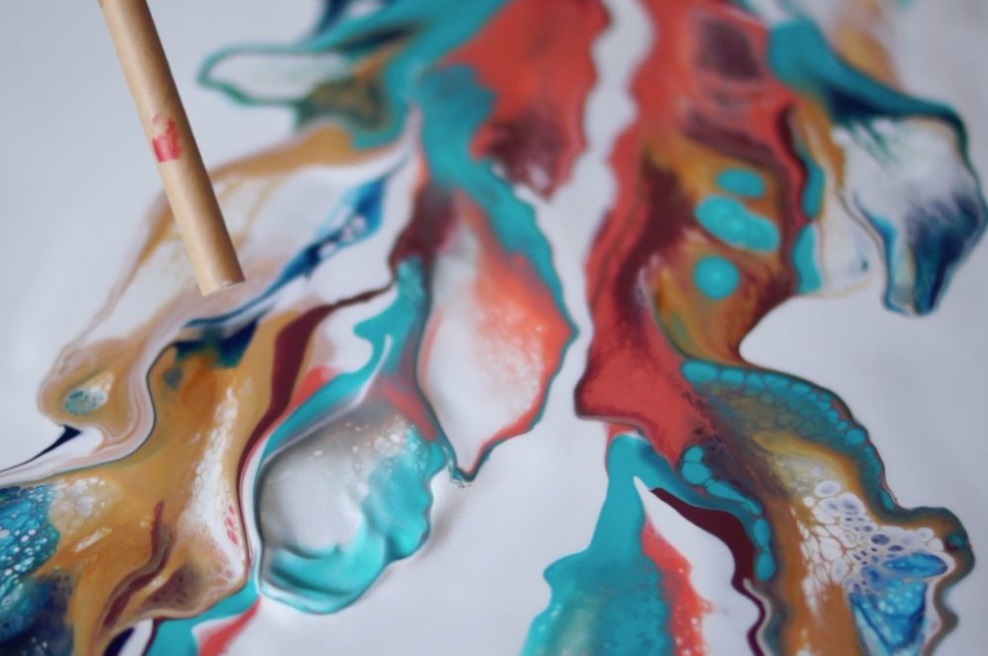













So Helpful!! Thank you!
Thank you for this thorough exploration into pouring mediums. As Marva said…so helpful!
Bec, this is the best instructions I’ve found on paint pouring. Thank you!
got a very simple question for you can u use any pva glue ??thanks